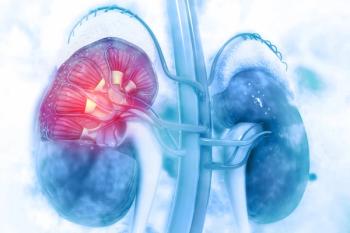
CXCR4 Inhibitor Active in Clear Cell RCC
Combination treatment with a novel CXCR4 inhibitor and axitinib resulted in an encouraging overall response rate and disease control rate in patients with clear cell renal cell carcinoma, according to the results from phase I of a phase I/II trial.
Combination treatment with a novel CXCR4 inhibitor and axitinib resulted in an encouraging overall response rate and disease control rate in patients with clear cell renal cell carcinoma (RCC), according to the results from phase I of a phase I/II trial presented at the 2017 AACR-NCI-EORTC Molecular Targets and Cancer Therapeutics Conference, held October 26–30 in Philadelphia.
“The combination of CXCR4 inhibition and VEGFR inhibition shows promising clinical results in this very difficult-to-treat population of patients with clear cell RCC. These results suggest that X4P-001-IO may address some of the limitations and augment the clinical utility of axitinib, which is a clinically meaningful drug in the treatment of patients with advanced metastatic clear cell RCC,” said lead investigator Michael Atkins, MD, of the Georgetown Lombardi Comprehensive Cancer Center in Washington, DC.
CXCR4 is a chemokine receptor that modulates immune function and angiogenesis through the trafficking of key immune cells such as T cells, dendritic cells, and myeloid derived suppressor cells. CXCR4 signaling is disrupted in a broad range of cancers, facilitating tumor growth by allowing cancer cells to evade immune detection and creating a pro-tumor microenvironment.
Atkins presented results from the 16 patients with advanced clear cell RCC enrolled in the dose escalation part of the study. About one-third (31%) of patients in the study had received at least one prior line of therapy, and 69% had received at least two prior lines of therapy. Data from the data cutoff date of October 2, 2017 were presented.
The objective response rate was 29% including one patient who achieved a complete response. The overall disease control rate was 93%. The median duration on treatment was 22.1 weeks; 44% of patients had been exposed to study treatment for at least 24 weeks.
Regarding safety, the drug combination was considered to be safe and well tolerated. The most common treatment-related adverse events were hypertension, diarrhea, fatigue, nausea, decreased appetite, headache, and dry eye.
“These results, while early, are very promising with a strong disease control rate and a manageable safety profile,” Atkins said.
Based on the phase I portion of the study, a dose of 400 mg X4P-001-IO once daily with 5 mg axitinib twice daily was selected for the ongoing phase II portion of the study. The phase II portion will evaluate clinical efficacy by measuring objective response rate, duration of response, and progression-free survival.
Newsletter
Stay up to date on recent advances in the multidisciplinary approach to cancer.
















































































